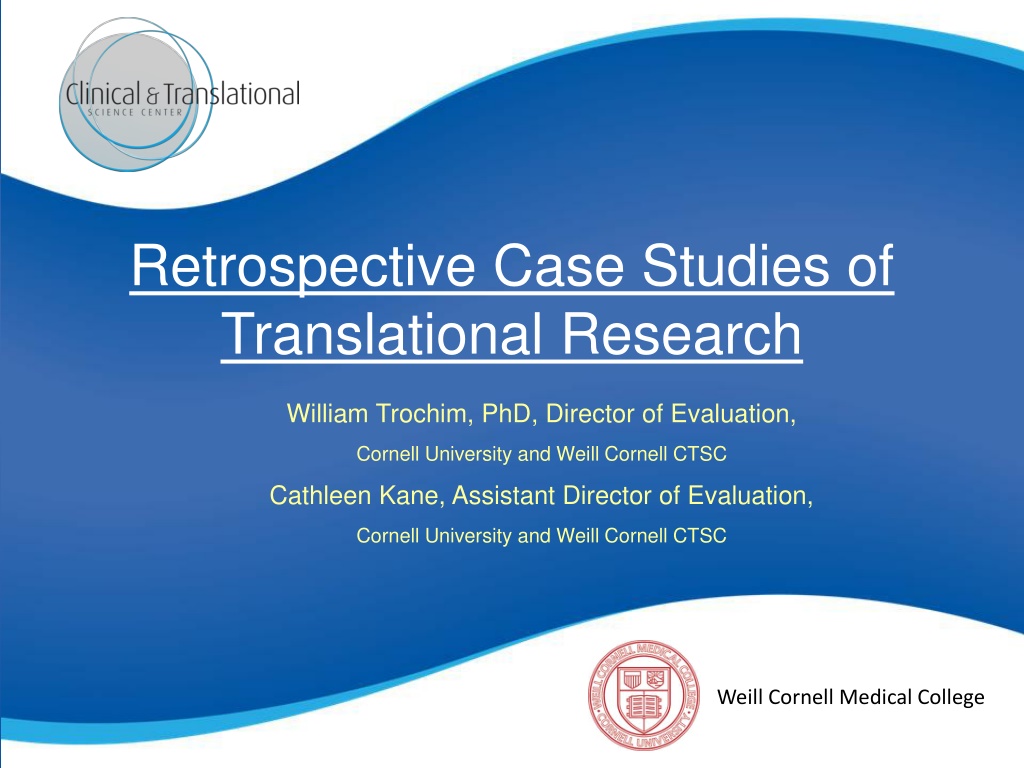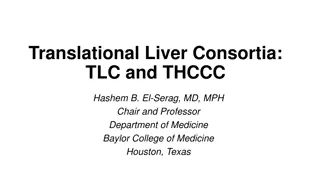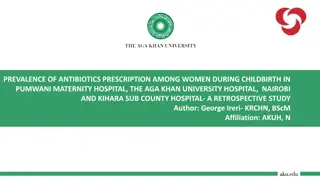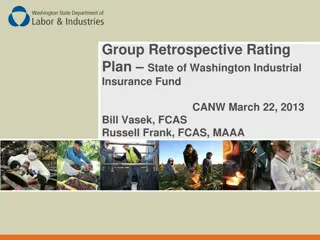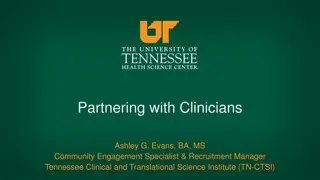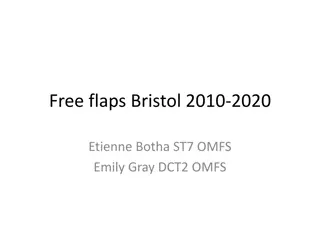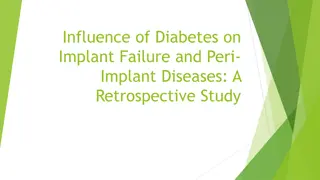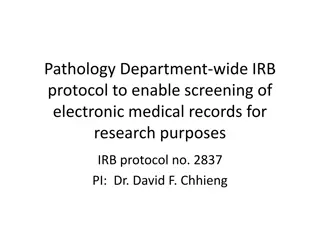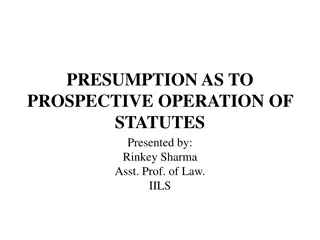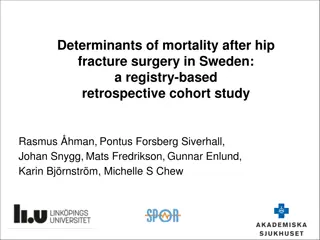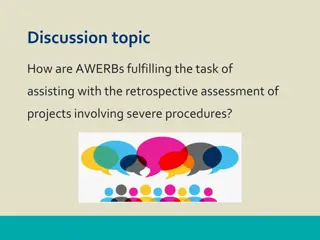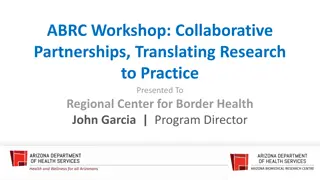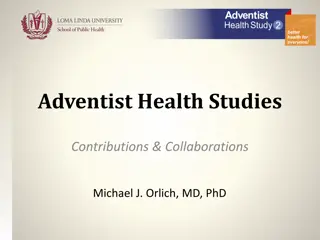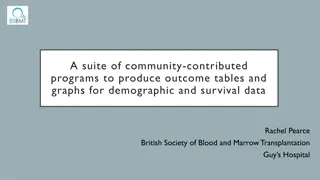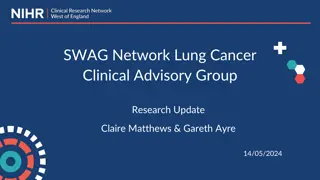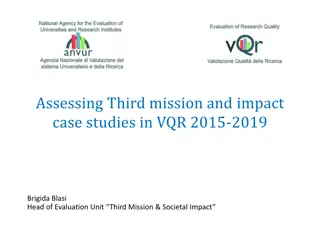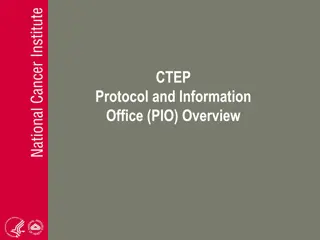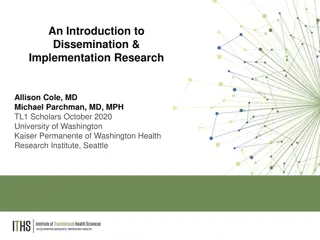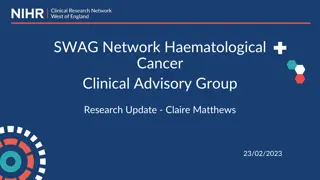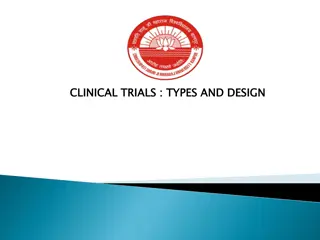Retrospective Case Studies of Translational Research: A Comprehensive Analysis
This study delves into the translational research process through retrospective case studies, shedding light on successful translations documented through mixed methods including bibliometrics, key marker measurements, and intensive interviewing. It reflects on the evolution of translational science, with a focus on a notable case involving the development of Gleevec, highlighting pivotal milestones and collaborations that shaped its trajectory.
Download Presentation

Please find below an Image/Link to download the presentation.
The content on the website is provided AS IS for your information and personal use only. It may not be sold, licensed, or shared on other websites without obtaining consent from the author. Download presentation by click this link. If you encounter any issues during the download, it is possible that the publisher has removed the file from their server.
E N D
Presentation Transcript
Retrospective Case Studies of Translational Research William Trochim, PhD, Director of Evaluation, Cornell University and Weill Cornell CTSC Cathleen Kane, Assistant Director of Evaluation, Cornell University and Weill Cornell CTSC Weill Cornell Medical College
Translational Process: Retrospective Case Study Goals Understand the entire translational process (we don t have 17 years!) Develop a standardized protocol for retrospective translational case studies Approach: mixed methods Evolutionary perspective Bibliometrics and key marker measurement (e.g., patents) Intensive Interviewing Case selection criteria Had to be a successful translation Recent enough to be documented and interviewed CTSC partners had to have key involvement
Translational Process: Retrospective Case Study May 28, 2001
Translational Case Studies: Gleevec Translational Markers by Year 14 Systematic reviews FDA approval events Clinical trial publications Clinical trial starts Patenting events Origin Studies 12 Group in Basel, Switzerland discover chemical (gleevec or imatinib) that was an ABL (tyrosine kinase) inhibitor 10 Number of Events) 8 molecular cloning of the breakpoint allowed the molecular definition of the genes; one was the very well studied Abelson Virus (ABL) a tyrosine kinase 6 first description of the Philadelphia chromosome 4 chromosomal banding dyes 2 0 1998 2008 2010 1960 1962 1964 1966 1968 1970 1972 1974 1976 1978 1980 1982 1984 1986 1988 1990 1992 1994 1996 2000 2002 2004 2006 Years (1960-2010)
Translational Case Studies: Gleevec Dr. Charles Sawyer Translational Markers by Year 14 Systematic reviews FDA approval events Clinical trial publications Clinical trial starts Patenting events Origin Studies and said you know do you think we should try to do a clinical trial? Have you ever done a clinical trial? No, have you? No (chuckle). I was in California in this lab that had cloned the gene. He (Brian Druker) was in this other lab and he s hearing about the drug and interested in this question he invited me to be the guest speaker and then he showed me all this data We told the drug company (CIBA Geigy, now Novartis) this drug really works and not only is it working, it works better than any other drug in this space has ever worked so you have to do something now They asked why do we want to treat this disease for which there s only 5000 new patients a year and this is just totally not a big pharma project? 12 10 Number of Events) 8 anyway this group of patients self-organized and created almost the entire CML patient population petition that went straight to the CEO who had no idea how important it was until that and then it was all right we have a problem because we need to scale this really fast, we haven t manufactured enough drug and we don t have enough manufacturing capacity right now to just do it so they had to outsource a lot of drug synthesis and so forth but you know it all worked out. I had to start being very careful in my physician/patient conversations because they would all be on the web that night when I would get home. So I see 20 patients in clinic, I could go home, be exhausted, log on to NewCMLdrug.com and patients would say well Dr. Sawyer today told me blah blah blah and then they d say well Dr. Druker tell me blah blah blah 6 4 2 the FDA embraced this in all the right ways A very important component of getting rapid approval was the fact that another drug that came before called Interferon that was standard of care had used survival as the endpoint one trial which was done in the 90 s allowed all future trials to use the surrogate endpoint for approval so that s a very important component of the rapid (FDA) approval time. 0 1998 2008 2010 1960 1962 1964 1966 1968 1970 1972 1974 1976 1978 1980 1982 1984 1986 1988 1990 1992 1994 1996 2000 2002 2004 2006 it was in 1998 and then the drug was clearly working a year later and we presented the first data in mid- 99 and then late 1999 was when we launched the phase 2 studies and then the drug was approved in 2001 Years (1960-2010)
Translational Case Studies: Gleevec Translational Markers by Year 14 Systematic reviews FDA approval events Clinical trial publications Clinical trial starts Patenting events Origin Studies CML patients petition drugmaker 12 FDA approval First clinical trial Group in Basel, Switzerland discover chemical (gleevec or imatinib) that was an ABL (tyrosine kinase) inhibitor 10 Number of Events) 8 molecular cloning of the breakpoint allowed the molecular definition of the genes; one was the very well studied Abelson Virus (ABL) a tyrosine kinase 6 first description of the Philadelphia chromosome 4 chromosomal banding dyes 2 0 1998 2008 2010 1960 1962 1964 1966 1968 1970 1972 1974 1976 1978 1980 1982 1984 1986 1988 1990 1992 1994 1996 2000 2002 2004 2006 Years (1960-2010)
Translational Case Studies: Gleevec 1975-2009 Age-Adjusted U.S. Mortality Rates, All Ages (Rates are per 100,000 and are age-adjusted to the 2000 US Std Population) Fast Stats: An interactive tool for access to SEER cancer statistics. Surveillance Research Program, National Cancer Institute. http://seer.cancer.gov/faststats. (Accessed on 4-9-2013) 1.2 Translational Markers by Year 14 Systematic reviews FDA approval events Clinical trial publications Clinical trial starts Patenting events Origin Studies CML patients petition drugmaker 12 1 FDA approval First clinical trial Group in Basel, Switzerland discover chemical (gleevec or imatinib) that was an ABL (tyrosine kinase) inhibitor 10 0.8 Number of Events) 8 molecular cloning of the breakpoint allowed the molecular definition of the genes; one was the very well studied Abelson Virus (ABL) a tyrosine kinase 0.6 6 first description of the Philadelphia chromosome 0.4 4 chromosomal banding dyes 0.2 2 0 0 1998 2008 2010 1960 1962 1964 1966 1968 1970 1972 1974 1976 1978 1980 1982 1984 1986 1988 1990 1992 1994 1996 2000 2002 2004 2006 Years (1960-2010)
Lessons and Implications Lessons The start point and end point problems remain key Punctuated activity, not continuous Interdisciplinary collaboration was key Patient community self advocacy was key Methodological development was key Implications Integrating rich case study data with bibliometrics and records analysis was essential Retrospective case studies can be done and can yield valuable insights about translation
Postscript February 1, 2016 Pharmacies across the U.S. will begin receiving shipments of a generic form of the revolutionary cancer pill Gleevec this week after the drug lost its patent protection on Monday. The generic version of drug, known as imatinib, is likely to cost about 30 percent less than brand-name Gleevec, says Kal Sundaram, the CEO of Sun Pharmaceuticals, the Mumbai, India- based company that will make the first generic.
